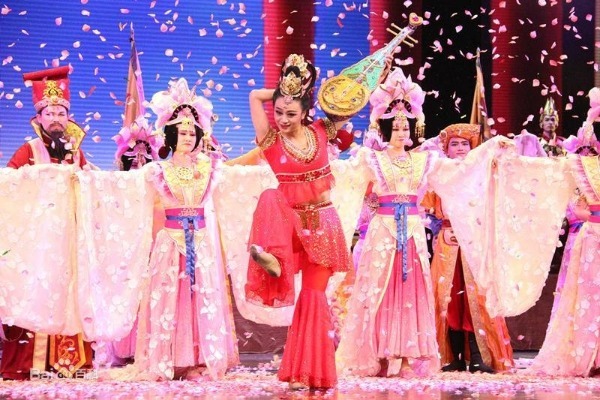Flower Rains Along The Silk Road: A timeless classic

[Photo provided to chinadaily.com.cn]
Artists of Gansu Song and Dance Ensemble (the current Gansu Opera and Dance Theater) broke the mental shackles formed during the cultural revolution and went to the depth of Dunhuang Mogao Grottoes in early years of the reform and opening-up.
With their acute artistic insight and other-worldly creativity, they produced a classic Chinese dance drama Flower Rains Along The Silk Road, which became the milestone in the history of China's Dunhuang dance school. The "S-shaped" dancing posture of Yingniang, the leading actress in the drama, when she plucks pipa from behind her back broke new ground in Chinese classic dance in terms of inheritance and innovation, and fueled the emergence of the Dunhuang dance school, which has its own unique dance vocabulary and aesthetic value, contributing to the diversity of Chinese dance schools.
The production of Flower Rains Along The Silk Road first started in 1978 when the artists sent by Gansu provincial Party committee arrived in Dunhuang in June of that year and wrote the first draft of the grand dances of Dunhuang Melodies.In July, the artists began composing and choreographing. At the end of August, the basic structure of the dance drama took shape, with its theme set to promotion of Sino-foreign friendship.
In February 1979, the rehearsal was a success; on May 23, the performance went on stage officially and was included in the performance program for the 30th anniversary of the founding of the New China in Beijing on October 1. The performance won the "First Prize of Creation" and the "First Prize of Performance" awarded by the Ministry of Culture. The dance drama depicts a moving story of a good-hearted Chinese father and his daughter who risk their lives to help a foreign businessman along the ancient Silk Road. With a unique artistic style, the drama showcases the beautiful Dunhuang murals and recreates the profound Dunhuang culture and the prosperity of the busy ancient Silk Road.
The drama has undergone constant revisions to cater to market needs in various periods of time, with 10 generations of performers (as many as 26 actresses for the "Yingniang" role) and multiple editions including the 2008 edition, the 2016 edition and the tourism site edition.
As the "Spring Herald of Reform and Opening-up", Flower Rains Along The Silk Road has been staged in nearly 40 countries and regions, as well as at the celebrations of the opening ceremony of the Beijing 2008 Olympic Games, the Expo 2010 in Shanghai, the 60th National Day anniversary, the opening ceremony of Silk Road (Dunhuang) International Cultural Expo among other major national events. Over the past 40 years, the drama has been staged for a total of 2,885 times and watched by more than 4.5 million persons/times. It has generated more than 300 million yuan in revenue. This fame and fortune have won the drama multiple honors and good reputation in China and the world including the "milestone in the history of Chinese dance drama", the "model of Chinese dance dramas", and the "Oriental Swan Lake".
In 2009, Flower Rains Along The Silk Road won the "First Outstanding Repertory Opera Award" of the Ministry of Culture, which marked the highest plaudit to the drama, a classic Chinese dance drama that came into being in the spring breeze of the reform and opening-up. With the opportunities of cultural exchanges boosted by the Belt and Road Initiative, Flower Rains Along The Silk Road has been on world tour to act as a bridge for people-to-people exchanges, and it will surely have a far-reaching impact on Chinese dance history.





 Print
Print Mail
Mail
